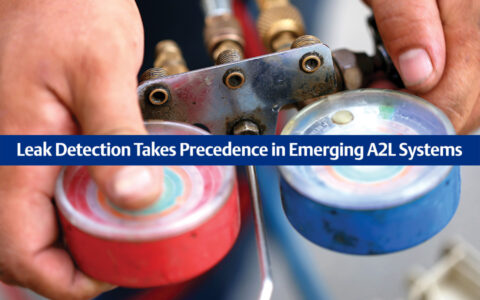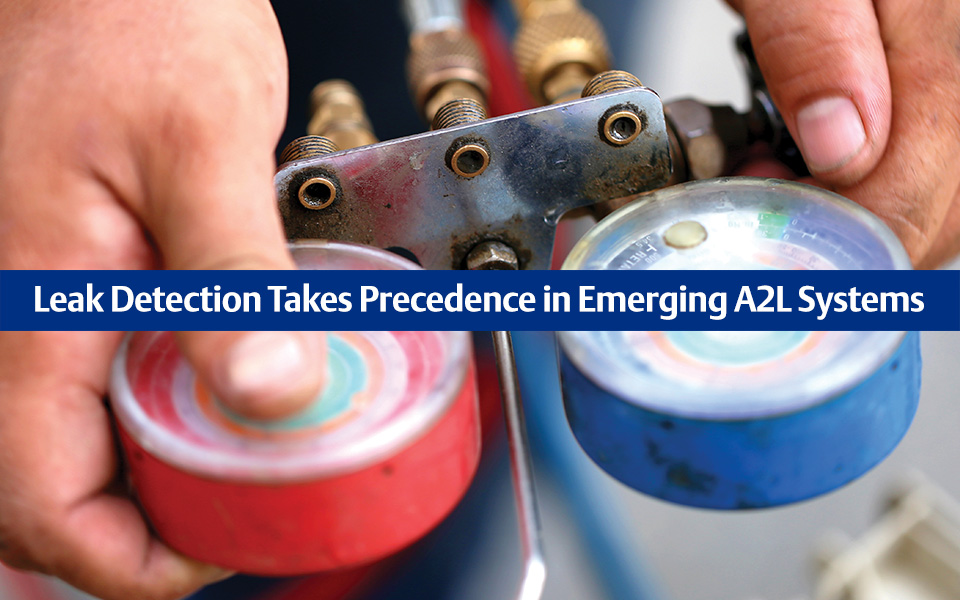Leak Detection Takes Precedence in Emerging A2L Systems

Refrigerant leak detection is considered a fundamental component and best practice in commercial refrigeration system design. Regardless of refrigerant, reducing leaks is important for a variety of performance, environmental and safety reasons. As mildly flammable A2L refrigerants emerge in U.S. markets, leak detection strategies will become even more essential — if not mandatory in certain situations — for ensuring operational safety. In a recent article for Facility Executive, I explored the need for leak detection in A2L refrigeration applications.

Safety has always been a key driver in refrigerant leak detection strategies. Staying below acceptable refrigerant concentration limits (RCLs) is necessary to meet Occupational Safety and Health Administration (OSHA) exposure limit regulations in numerous applications. System performance and efficiency are other key metrics tied to reducing refrigerant leaks, as properly charged, non-leaking systems deliver maximum refrigeration performance, reduced maintenance issues and improved energy efficiencies.
In legacy systems that use hydrofluorocarbon (HFC) refrigerants with high global warming potentials (GWPs), reducing leaks is a matter of environmental protection. And as HFCs continue to be phased down per U.S. regulations, preserving these refrigerant charges will be important to avoiding unnecessary replacement costs.
Next-generation leak detection requirements
Updates to U.S. regulations, codes and standards are currently underway to approve A2L refrigerants. Meeting the proposed GWP thresholds of 150 and 300 will require the use of emerging refrigerants, including A2Ls that have varying degrees of “lower flammability”. As A2L refrigerants become more commonplace, certain system architectures will require the use of specific leak detection strategies to mitigate the potential for flammability and ensure operational safety.
Installing remote systems with A2L refrigerants requires the use of safety strategies and mitigation measures to keep gas concentrations below flammable thresholds. Per the UL 60335 2-89 standard, A2L systems must be designed to detect refrigerant leaks at various points of the refrigeration circuit — from the compressor to the condensing unit to the case — and then take immediate action to mitigate flammability risks.
Specific mitigation methods are based on the total application refrigerant charge, the flammability rating of the A2L, the installation size, its location and equipment type (i.e., walk-in unit or display case and the room in which it is located). Where required, safety strategies rely on a combination of leak detection and mitigation technologies:
- Leak detection and safety shut-off valves to limit releasable charge
- Air circulation fans and/or ventilation strategies
- Integrated system controls with A2L logic
Copeland A2L leak detection solutions
Copeland offers a full suite of leak detection sensors, devices, valves and compression for emerging A2L refrigeration systems. The following refrigerant leak detection solutions are designed to identify the presence numerous A2L refrigerant options.
Refrigerant leak detection system (RLDS) — Our multi-zone, aspirated system is designed to detect leaks early and minimize refrigerant loss.
- Continuously monitors up to 16 separate zones
- Audible alarm, front panel indicators and built-in relays can trigger external alarm devices in case of fault for immediate response
- Detection range: 0–10,000 PPM
MRLDS 450 gas detector — This modular, point sensor system offers 24/7 A2L monitoring for safety and/or compliance purposes.
- Fully integrated to building management system (BMS), such as the E3 supervisory controllers
- Mobile app interface supports simple, remote troubleshooting and calibration
- Pre-calibrated sensors enable faster installation
- Detection range: 0–1,000 PPM
MRLDS 250 — Our broadband model provides infrared A2L leak detection and can be used on a stand-alone basis or integrated into a BMS.
- No calibration required
- Onboard LED leak indicator and audible alarms
- Simple interface allows quick set-up of all parameters
- Detection range: 0–3,500 PPM
Copeland is preparing for A2Ls in commercial refrigeration by designing the next generation of A2L compression, leak detection, mitigation and control technologies. We’re committed to helping original equipment manufacturers (OEMs), contractors and end users maximize A2L safety while minimizing system complexities. By integrating components, leak detection devices and system controls, we’re simplifying the application of A2Ls while helping to ensure safe, reliable refrigeration performance. Our application engineers are available to help you deploy an effective A2L leak detection strategy.

Six Ways to Reduce Food Waste by Tracking the Supply Chain
by Gerd Uitdewilligen | Cold Chain
*Emerson’s Climate Technologies business is now a new standalone company: Copeland. Over the next...

Protect Valuable Shipments in High-Crime Areas
by Lissandra Rodriguez | Cold Chain
*Emerson’s Climate Technologies business is now a new standalone company: Copeland. Over the next...

Real-time Tracking Protects Valuable Mango Cargo
by Andres Toro | Cold Chain
*Emerson’s Climate Technologies business is now a new standalone company: Copeland. Over the next...
The post Leak Detection Takes Precedence in Emerging A2L Systems appeared first on Copeland E360 Blog.